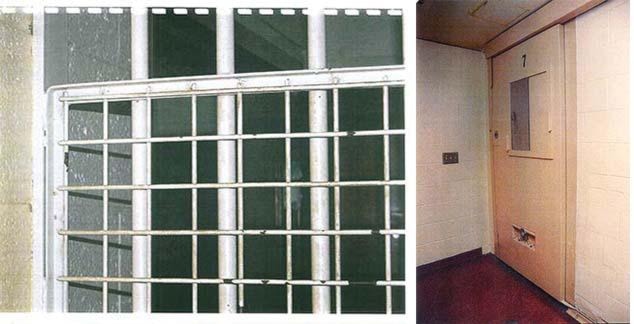The Cranbrook cell block was under renovations when Collan Kohalyk hanged himself in custody on December 24, 2010.
Former Inspector of the Cranbrook RCMP detachment Bryan Edmondson testified at the Coroner's Inquest on Wednesday, October 10.
Construction had begun on half of the cellblock but had ceased for the Christmas holidays when Kohalyk was brought to the cells under arrest for a domestic assault. Edmondson said a Canada-wide retrofit of all police holding cells had been ordered and the City of Cranbrook had approved a nearly $300,000 renovation of the five out of 10 cells at the RCMP detachment.
"When the cellblock was constructed, this was the standard of the day," Edmondson said of the existing cells. "Over time the standards have changed and evolved."
The new retrofit would rid the cellblock of bars and instead use heavy steel doors with viewing windows and repositioned cameras allowing a complete view of each cell.
The cell in which Kohalyk hanged himself has not been retrofitted to this date, but Edmondson said when he retired in February of this year, it was on the City of Cranbrook's five year budgetary plan to complete the retrofitting of all the cells in the block.
Several policies were changed following Kohalyk’s death 10 days later at Kelowna General Hospital from a brain injury. Edmondson said the camera in cell number one where the incident occurred was repositioned to allow a complete view. Since the renovations were completed, cell number one and the additional old-style cells have only been used by no-risk prisoners when absolutely necessary. High risk prisoners are those with infectious diseases, those that pose a risk of suicide and someone convicted of a long prison sentence for a crime.
On Tuesday, RCMP members involved with the arrest of Kohalyk all stated they had no previous knowledge of mental illness or risk of suicide when they arrested the man.
The family told a different story when they testified Wedesday. Kohalyk’s mother Irene Kohalyk said her son was diagnosed as bi-polar as an adult and had struggled with addiction. He spent time in rehab facilities on three separate occasions and had been assaulted and hospitalized three times throughout his struggles. Edmondson said RCMP members do not have access to any medical records and a restraining order placed on Kohalyk by his former girlfriend a month before the domestic assault arrest was the first time he had contact with the police.
The cellblocks were targeted for renovations in September 2009 – more than a year before Kohalyk arrived at the cells – and construction began on December 13, 2010. It ceased on December 17 for the Christmas break. The new cells became operational in spring of 2011.
During the renovations, Edmondson did a usage study of the cellblock, and determined that in 2008 five cells or less were needed 79 per cent of the time. The need to use all 10 cells arose only 0.5 per cent of the time and a total of 1,000 to 1,200 prisoners are housed each year at the detachment. The largest capacity the cells have ever seen was 17 people in 2009.
After Kohalyk’s death, Edmondson examined the Closed Circuit Television (CCTV) coverage and determined there was a blind spot in cell one that he had never noticed in his 10 years of personal daily checks of the cells. He said when he views the cells on the camera he was often paying attention to what the subject was doing rather than the area of coverage of the camera. He said there is no policy that states guards must physically check the cells a certain number of times, but said he expects it happens 50 per cent of the time. Guards now have to report if they physically checked or looked on the CCTV monitors.
Kohalyk used his own T-shirt to hang himself, and the inquest heard Tuesday that RCMP officers had refrained from removing clothing that he had stripped off because he was being combative and violent.
Edmondson admitted when probed by the jury that there is no policy that encourages more frequent checks by guards for those prisoners who have removed their clothing. He said it was common for prisoners to remove their clothing and later put it back on.
“All clothing poses a risk,” Edmondson said. “The ideal situation would be no clothing but I don’t think that’s practical.”
He told the jury that those prisoners who are flagged as possibly suicidal are given jumpsuits that tear easily and cannot support the weight of a person. The jury asked if it may be possible for all prisoners to wear the jumpsuits, but Edmondson said that would still put officers at risk with violent prisoners, and would be difficult as they often shuttle people to court and back.
Other changes to the cells after Kohalyk’s death was the removal of the vertical bars where it was structurally feasible. Prisoners are now double bunked in these cells if they must be used, with the expectation that the cellmate could intervene or alert a guard if an incident occurs.
